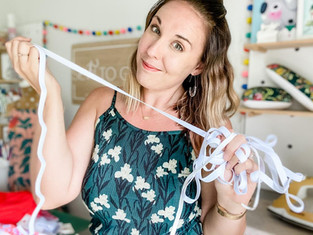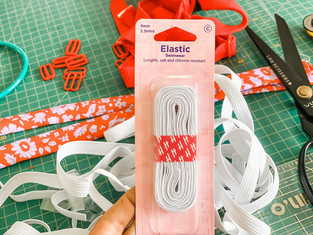Everything you need to know about elastic
Updated: Apr 18, 2023
This week's question comes from Kathy Borst, who will now receive a FREE PDF pattern!
She wants to know all about elastic. What's the best type to use? How to sew it so it doesn't stretch out of shape? Let me give you a few hints and tricks on this...

Well there are just so many different types of elastics out there for different projects. Some are specifically suited to activewear and swimsuits, meaning that it can handle the constant strain that the activewear undergoes. Then you have braided, knitted, and woven/non-roll elastic. Each with their special properties.
✂️Braided elastic narrows when pulled and can loose elasticity when sewn over. I tend to use braided elastic in casings around my waist or sleeves. This is when you sew a channel and use a safety pin or bodkin to thread the elastic through. I've also zig-zagged over it but only when the zigzag is wider than the elastic when pulled.
✂️Knitted elastic doesn't narrow when stretched and is much smoother than braided elastic. I find this elastic works well for waistbands and can be zigzagged into a light weight garment. I don't use this one too often though because I find it is the one that wears out most quickly when washed and worn often. Think of your undies that have lost their stretch.
✂️ Non-roll/Woven elastic is the most durable and great to use in outerwear and heavier garments.
✂️For the most part, you always cut the elastic slightly smaller than what you are attaching it to. This way when you stretch and zigzag over it, or thread it through a casing it will cause it to gather up and allow stretch and movement when you put on the garment.
✂️When using 1/4" narrow elastic and zigzagging over it, I like to divide the garment into quarters and the elastic into 1/4s as well. I then match the quarters and pull the elastic straight while holding the garment straight as well. This takes some practice as it requires 2 hands and holding the fabric and elastic differently, but lining up the marks really helps.
✂️ Finally, after the elastic is in the garment, I sometimes decide to secure the elastic by pulling the garment straight and running a straight stitch through the elastic. You have to do this once the elastic is already sewn into the garment and make sure it is pulled completely flat, other wise your stitching will pop when you go to put on your garment.
Hope this helps!
Let me know what sewing questions you'd like answered by emailing marketing@sewtogrow.com.au













Comentários